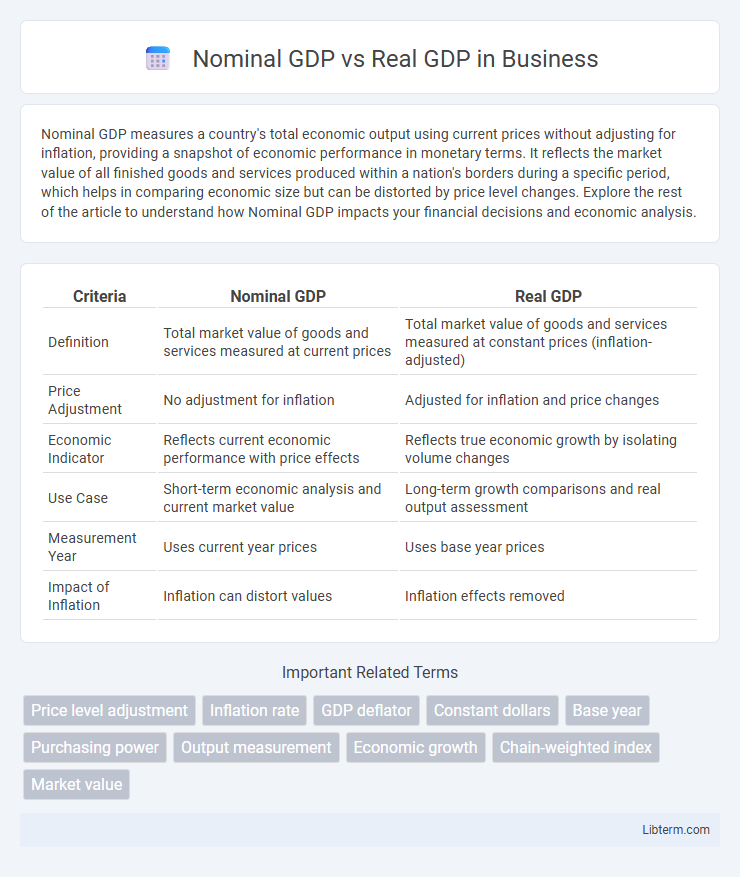Nominal GDP measures a country's total economic output using current prices without adjusting for inflation, providing a snapshot of economic performance in monetary terms. It reflects the market value of all finished goods and services produced within a nation's borders during a specific period, which helps in comparing economic size but can be distorted by price level changes. Explore the rest of the article to understand how Nominal GDP impacts your financial decisions and economic analysis.
Table of Comparison
| Criteria | Nominal GDP | Real GDP |
|---|---|---|
| Definition | Total market value of goods and services measured at current prices | Total market value of goods and services measured at constant prices (inflation-adjusted) |
| Price Adjustment | No adjustment for inflation | Adjusted for inflation and price changes |
| Economic Indicator | Reflects current economic performance with price effects | Reflects true economic growth by isolating volume changes |
| Use Case | Short-term economic analysis and current market value | Long-term growth comparisons and real output assessment |
| Measurement Year | Uses current year prices | Uses base year prices |
| Impact of Inflation | Inflation can distort values | Inflation effects removed |
Introduction to GDP: Defining the Basics
Nominal GDP measures the total market value of all finished goods and services produced within a country's borders using current prices, reflecting inflation or deflation effects. Real GDP adjusts nominal GDP by accounting for changes in price level, providing a more accurate representation of an economy's true growth by using constant prices from a base year. Understanding the difference between nominal and real GDP is crucial for analyzing economic performance and making informed policy decisions.
What is Nominal GDP?
Nominal GDP measures the total market value of all finished goods and services produced within a country's borders in a specific time period, using current prices without adjusting for inflation or deflation. It reflects the economy's size by capturing changes in both production volume and price levels. This contrasts with Real GDP, which adjusts for price changes to provide a more accurate picture of economic growth.
What is Real GDP?
Real GDP measures the value of all finished goods and services produced within a country's borders, adjusted for inflation or deflation to reflect the true purchasing power over time. Unlike Nominal GDP, which is calculated using current prices, Real GDP uses constant prices from a base year, enabling accurate comparisons of economic performance across different periods. Policymakers and economists rely on Real GDP to assess economic growth, productivity, and living standards without distortions caused by changing price levels.
Key Differences Between Nominal and Real GDP
Nominal GDP measures the total market value of all final goods and services produced within a country using current prices, reflecting both price changes and output. Real GDP adjusts for inflation by valuing output at constant prices, providing a more accurate representation of an economy's true growth. The key difference lies in Nominal GDP's sensitivity to price fluctuations, while Real GDP isolates volume changes, serving as a crucial indicator for comparing economic performance over time.
The Role of Inflation in GDP Measurement
Nominal GDP measures the total market value of goods and services produced in a country using current prices, which includes the effects of inflation. Real GDP adjusts for inflation by using constant prices from a base year, providing a more accurate representation of economic growth over time. Inflation can distort nominal GDP figures, making real GDP essential for comparing economic performance across different periods without price level influences.
Why Real GDP Offers a Clearer Economic Picture
Real GDP adjusts nominal GDP by accounting for inflation, providing a more accurate measure of an economy's true growth over time. It reflects the actual increase in goods and services produced, removing price level distortions that can mislead economic analysis. This adjustment enables policymakers and economists to make better-informed decisions based on genuine economic performance rather than fluctuating market prices.
How to Calculate Nominal and Real GDP
Nominal GDP is calculated by multiplying the current market prices of all final goods and services produced within a country by their respective quantities during a specific period. Real GDP is derived by adjusting the nominal GDP for inflation, using a base year's price levels to reflect the true economic output. The formula for Real GDP is Nominal GDP divided by the GDP deflator, then multiplied by 100 to remove the impact of price changes over time.
Limitations of Nominal GDP
Nominal GDP reflects the market value of goods and services produced in a country using current prices, making it susceptible to distortions from inflation or deflation. This limitation means nominal GDP can overstate or understate economic growth by not accounting for changes in price levels over time. Real GDP addresses this issue by adjusting for inflation, providing a more accurate measure of an economy's true output and purchasing power.
Practical Applications: Nominal vs Real GDP in Policy Making
Nominal GDP reflects current market prices, while Real GDP accounts for inflation-adjusted output, providing a clearer economic performance measure over time. Policymakers rely on Real GDP to design fiscal and monetary policies that accurately address economic growth without distortion from price level changes. Understanding the divergence between Nominal and Real GDP is essential for setting interest rates, taxation, and government spending decisions to promote sustainable economic development.
Conclusion: Choosing the Right Metric for Economic Analysis
Nominal GDP measures the market value of all final goods and services produced in a country without adjusting for inflation, reflecting current prices. Real GDP adjusts nominal GDP for inflation, providing a more accurate representation of an economy's true growth and purchasing power over time. For precise economic analysis and policy-making, Real GDP is preferred because it isolates growth from price changes, enabling better comparisons across different time periods.
Nominal GDP Infographic

 libterm.com
libterm.com